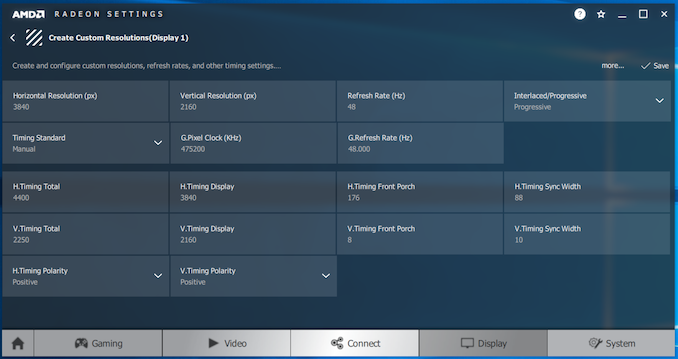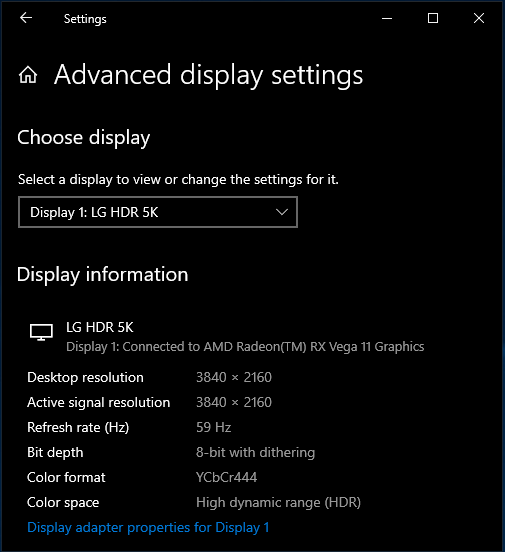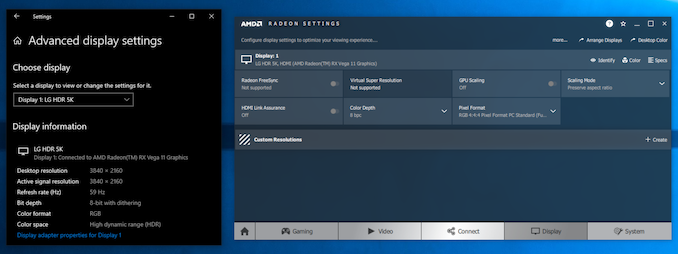The ASRock DeskMini A300 Review: An Affordable DIY AMD Ryzen mini-PC
by Ganesh T S on April 26, 2019 8:00 AM ESTHTPC Credentials - Display Outputs Capabilities
The
| ASRock DeskMini A300 Display Outputs | |||
| HDMI | DisplayPort | VGA | |
| Version | 2.0a | 1.2 | N/A |
| Max. Video Output | 3840x2160 @ 60Hz | 4096x2160 @ 60Hz | 2048x1536 @ N/A |
| HDCP | Yes (2.2) | N/A | |
| HDR | Yes | No | No |
| HD Audio Bitstreaming | Yes | N/A | |
Supporting the display of high-resolution protected video content is a requirement for even a casual HTPC user. In addition, HTPC enthusiasts also want their systems to support refresh rates that either match or be an integral multiple of the frame rate of the video being displayed. Most displays / AVRs are able to transmit the supported refresh rates to the PC using the EDID metadata. In some cases, the desired refresh rate might be missing in the list of supported modes.
Custom Resolutions
Our evaluation of the
We tested out various display refresh rates ranging from 23.976 Hz to 59.94 Hz. Of particular interest is the 23.976 Hz (23p) setting.
The gallery below presents screenshots from the other refresh rates that were tested. The system has no trouble maintaining a fairly accurate refresh rate throughout the duration of the video playback.
High Dynamic Range (HDR) Support
The ability of the system to support HDR output is brought out in the first line of the madVR OSD in the above pictures. The display / desktop was configured to be in HDR mode prior to the gathering of the above screenshots.
By default, the DeskMini A300 drives a YCbCr 4:4:4 signal to the display in HDR mode. This is in contrast to the sub-samped (4:2:2 or 4:2:0) formats used by other GPUs. 4:4:4 ensures that the desktop doesn't have any chroma sub-sampling artifacts leading to fuzzy display of text content. The Readeon Settings application allows for easy configuration of any desired pixel format. We were also able to configure a RGB 4:4:4 full level signal (0-255) in the HDR mode.
AMD systems do not support the Software Guard Extensions (SGX) feature needed to play back UHD Blu-rays. Hence, we didn't bother running the CyberLink UHD Blu-ray Advisor Tool in the DeskMini A300.




















88 Comments
View All Comments
abufrejoval - Friday, April 26, 2019 - link
Or an M.2 slot? They seem to have forgotten that slots were for extensibility and I would very much like the ability to upgrade to an NBase-T via an M.2 card (unless included)... They have lots of creative solutions for servers...Unfortunately I see only confusion ahead: With USB4 and x0-Gbit Ethernet, bandwidth won't be an issue, but latency, interoperability and turf wars might last forever.
mooninite - Friday, April 26, 2019 - link
Finally! A Ryzen + Vega mini PC! It blows a more expensive, Intel Iris NUC out of the water. Amazing!PeachNCream - Friday, April 26, 2019 - link
It does so it's a nice option for iGPU gaming. However Bean Canyon and other Iris parts are at a notable TDP disadvantage. I doubt the extra headroom would make up much of the difference, but if the Iris parts had additional power and cooling to put them on an even footing, I don't believe the advantage would be as significant. Despite that, I do like Ryzen and think its a worthwhile trade-off to make for a gaming use case.abufrejoval - Friday, April 26, 2019 - link
So I thought, too. But then I looked at the power figures idle and max at the wall plug: Much less actual difference than 15/65 Watt would make you believe.Alexvrb - Saturday, April 27, 2019 - link
Plus the 3200G/3400G may drop TDP further. Although, can't you cTDP the 2x00G models to 45W already?mikato - Tuesday, April 30, 2019 - link
I like your thinking, but will it take them almost a year to get out a mini PC for those once they are released? Ugh.Alexvrb - Tuesday, April 30, 2019 - link
It's an AM4 barebones. The 3000 CPUs are Zen 2, but the 3200G/3400G APUs are just tweaked Zen+ based models, 12nm but (similar to RX 590) probably not a true dieshrink. I'm not even sure if you'd need a newer-than-current BIOS update for them to boot (though it would be recommended regardless). At any rate that's all that you might need, a BIOS update.mikato - Tuesday, April 30, 2019 - link
Yeah I agree - idle power usage of 11.24 watts for this DeckMini A300 vs the 8.45 watts of the NUC8i7BEH with Bean Canyon. That's a difference of only 2.8 watts!Irata - Wednesday, May 1, 2019 - link
And this difference may very well be due to other factors like PSU, memory, mainboard....eastcoast_pete - Friday, April 26, 2019 - link
Question/Showing my ignorance of the capabilities of the chipset here: so, with this setup, is it possible to fine-tune the 2400G's CPU and GPU (undervolting, adjusting the frequency)? It sounds as if none of that would be possible, but again, I have no experience with this chipset and MoBo.